Two LANCOM routers are inter-connected over a WAN link and they are to be configured to use BGP to propagate certain IPv4 networks. The routers are a LANCOM 1800VAW at the main office and a LANCOM 1800VA-4G at the branch office.
Note: We assume that a WAN connection exists between the two devices.
-
Enabling BGP: Open the menu item Routing protocols > BGP in the configuration of both routers and activate the Border Gateway Protocol (BGP) active check box. This enables BGP on that specific device. In the next steps you configure each BGP instance, the associated neighbors, and the networks that are to be propagated.
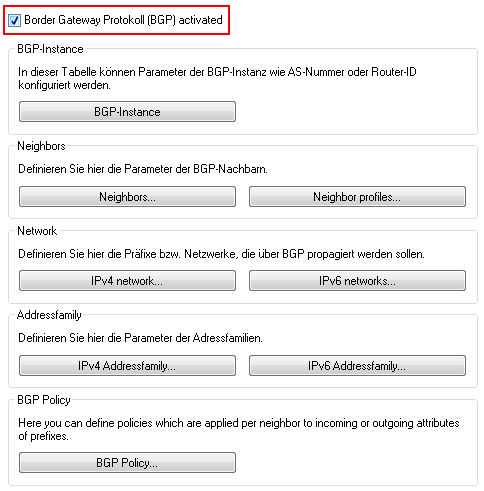
-
Configuring individual BGP instances: To configure the BGP instance of each router, click the BGP instance button.
-
Use the configuration window to specify the general information about the BGP instance for each router. The screenshots below show the configurations for both devices for direct comparison side by side.
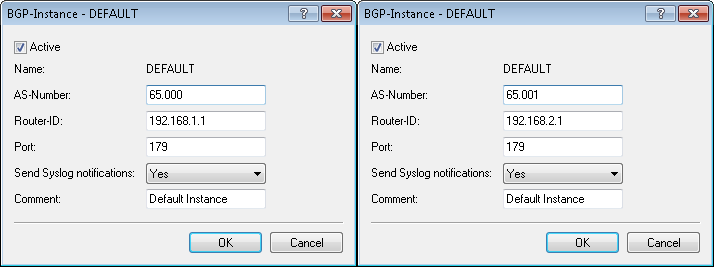 Note: The left half of the images shows the LANCOM 1800VAW, and the right half shows the parameters of the LANCOM 1800VA-4G.
Note: The left half of the images shows the LANCOM 1800VAW, and the right half shows the parameters of the LANCOM 1800VA-4G.Parameter Description Checkbox Active Enable the BGP instance of the router. This is necessary to enable communication between the two routers. AS number The AS number (Autonomous System number) collects routers into the same administration unit. Entering different numbers here specifies the eBGP peers. Identical numbers indicate peers that share the same AS (iBGP). Note: Learn which entries are valid by visiting http://www.iana.org/assignments/as-numbers/as-numbers.xhtml.Router ID Specify an IP address for the router. Enter 0.0.0.0 if you want the IP address to be set automatically. The router ID must be unique among the neighbors of a BGP router. Note: Different entries are required here.Port Configure the TCP-IP port that the router uses for inbound BGP connections. The default value is 179. Send Syslog notifications Specify whether the device is to generate SYSLOG messages. Use WEBconfig to view these. Comment Enter a comment to make it easier to understand the configuration later. -
Configuring the BGP neighbors: Once the configuration of the BGP instance is complete, the next step is to define the associated neighbors for exchanging information about the propagated networks. Click on the Neighbors button.
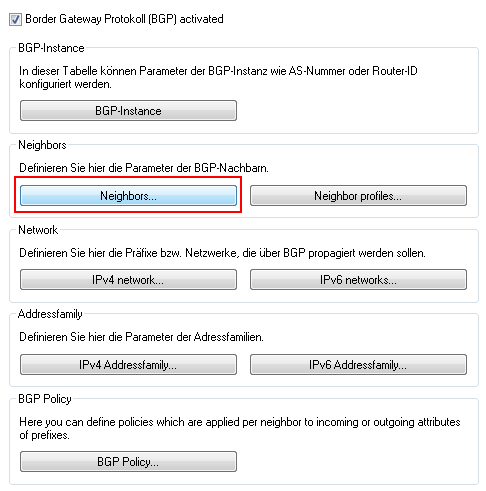
-
Click on the Add button to configure a new BGP neighbor. Use the configuration window to specify the information about the BGP neighbors for each router.
Note: The screenshots below show the configurations for both devices for direct comparison side by side. Here we only describe the configuration parameters that differ from the default values.
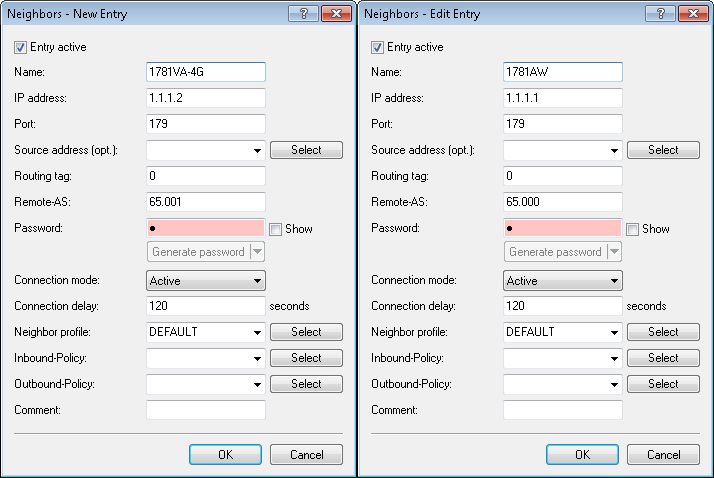 Note: The left half of the images shows the LANCOM 1800VAW, and the right half shows the parameters of the LANCOM 1800VA-4G.
Note: The left half of the images shows the LANCOM 1800VAW, and the right half shows the parameters of the LANCOM 1800VA-4G.Parameter Description Entry active Activate the entry for the corresponding neighbor. Name Set the name for the neighbor. This example uses an abbreviated version of the device name for easy identification in the configuration. IP address Enter the IP address where the neighbor is to be reached. In this example, the WAN address of 1800VAW is 1.1.1.1 and that of 1800VA-4G is 1.1.1.2. Remote AS Enter the AS numbers of the corresponding neighbors as specified in step 2. Password Enter a password, which is used to obscure communications between the two BGP neighbors by means of an MD5 hash. The password must be identical at both ends. -
Configuring the IPv4 networks to be propagated: Configure the networks that are to be propagated by the individual BGP instances. Click on the IPv4 networks button.
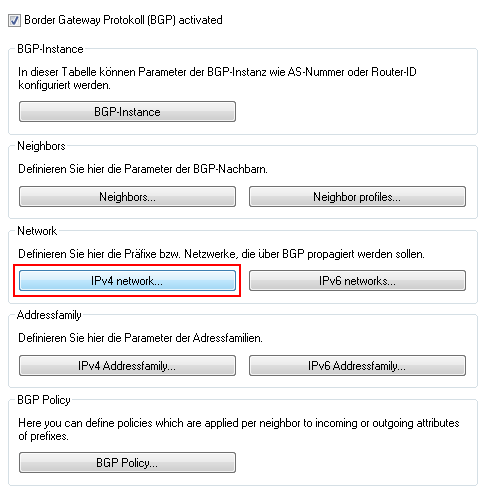
-
Click the Add button to define a new IPv4 network, which is to be propagated.
Note: The screenshots below show the configurations for both devices for direct comparison side by side. Here we only describe the configuration parameters that differ from the default values.
 Note: The left half of the images shows the LANCOM 1800VAW, and the right half shows the parameters of the LANCOM 1800VA-4G.
Note: The left half of the images shows the LANCOM 1800VAW, and the right half shows the parameters of the LANCOM 1800VA-4G.Parameter Description IP address The IPv4 address range of the network to be propagated. Netmask The netmask corresponding to the defined network. Type The type of propagation to be used. This example is static for ease of configuration. - Write the respective configurations back to the two devices.
-
The BGP connection is easily checked via the command line. The command show bgp-neighbor displays all active neighbors and their status.
> show bgp-neighbor BGP-Neighbors: 1.1.1.2, Rtg-Tag 0 BGP-State: ESTABLISHED, up for 00:09:23 remote AS 65001, remote router id 192.168.1.161, eBGP Neighbor capabilities: Four-octets ASN capability: advertised and received Address family IPv4 NLRI used for unicast forwarding: advertised and received > _
